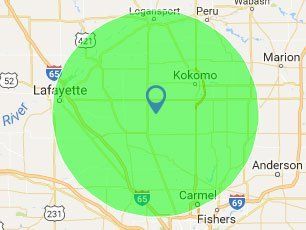Don't Let Pesky Wildlife Invade Your Space
Bats
Bats invading your property? The most common complaints include the following:
- Bats in attic
- Hearing scratching noises in attic or walls
- Bats exiting or entering home, chimney or basement
- Bat droppings on or around exterior of home or attic
Bat Species:
There are several different species of bats in Illinois but most problems we encounter are with Little Brown Bats and Big Brown Bats. First is the Little Brown Bat (Myotis lucifugus) which is common in most of the US, especially the more northward states. These bats are small, with a wingspan of 8 inches, and a weight of less than half an ounce. The females form large maternity colonies, often in buildings such as attics or barns. Young are born in June, and can fly by August. They can live up to 30 years apparently, though average lifespan in the wild may be about 7 years. They hibernate in the winter. The Big Brown Bat (Eptesicus fuscus) is also common in the northern areas. It has a wingspan up to 13 inches, and can live up to 19 years in the wild. They mate in October, before winter hibernation, and after a delayed fertilization and a 60 day gestation, give birth to one or two baby bats in early June. These Bats are unique and beneficial critters but when they start using our homes as their cave or entering our living space, they can pose a health risk to family and pets. Due to health risks and damage caused by bats living in our homes they present a unique problem because bats are beneficial to our environment and protected by law.
Bat Behavior:
Bats are nocturnal. They sleep in roosts during the daytime, and emerge at dusk. If it's a colony of bats living in a building, they crawl to the edge, and fly out. First they head for water and get a drink, skimming the surface on the wing. They then feast on flying insects, primarily moths and beetles. After a while they get full and head back to the roost in order to rest. They then fly back out to feed some more. They may make several trips per night. Bats use echolocation in order to aid in navigation and feeding on the wing. They emit high-pitched chirps and read the sonar-like returns of the sound waves as they bounce back off of objects. Roosting preference depends on the species and even gender of the bats, but we are only concerned with colonizing bats such as the three mentioned above. These colonies are composed primarily of females. The males roost alone in solitary areas, such as trees. The females form huge clusters, very frequently in man-made architecture such as church towers, attics, bridges, etc. They tolerate and even prefer very high temperatures. Many of the southern bats migrate to different areas as climates change. However, bats in the north hibernate in colder weather.
Nuisance Concerns:
The primary concern involves large colonies. If it's just a few bats, it may not be a big deal. However, if you've got a typical maternity colony of bats in your home or building, it can be a big problem. A large colony is not only noisy and unsettling at dusk and dawn as swarms of bats fly in and out, but the main problem is that they leave their droppings and urine behind. With a large colony of bats, this really adds up. After a while large piles of droppings form. Not only do the droppings and urine corrode wood/metal, but the weight of them can collapse the ceiling below the attic. The waste has a foul odor, but it can also grow fungal spores that people can breathe in, leading to the lung disease Histoplasmosis.
Bat Diseases:
Histoplasmosis, a fungal infection of the lungs that results from the fungus that grows on nitrogen-rich bat droppings, but it's also important to keep in mind the fact that the majority of the cases of rabies transmission in the United States have come from bats. This may be because people are less cautious around bats than say, rabid raccoons, or because bats are very small and can bite and infect people in their sleep. Or perhaps the particular strain of rabies that bats or certain species of bats carry is more likely to infect people. Regardless, if you see a sick bat on the ground, don't pick it up, because you might get bitten!
How to get rid of Bats:
Removing bats from a home, business, or structure unharmed, is very specialized work that can be done successfully by exclusion. Bat exclusion work is a methodical approach achieved through careful planning, timing and materials specific to bat exclusion. Seal off 100% of possible secondary entry points on the home and remove all of the bats from the building safely. It is often very challenging, and it must be done just the right way.
Call 765-586-2971 today! We're standing by to help.
We provide emergency
services. Call us at 765-586-2971 now!


